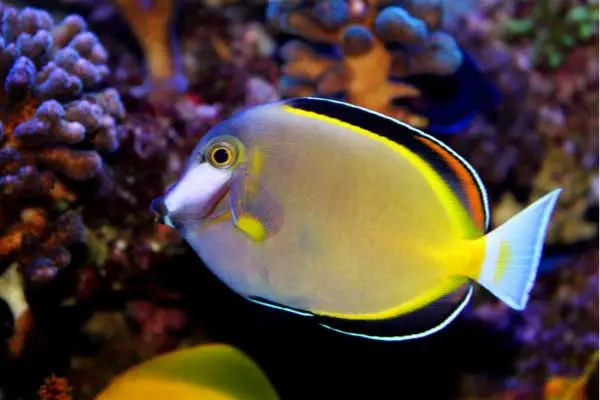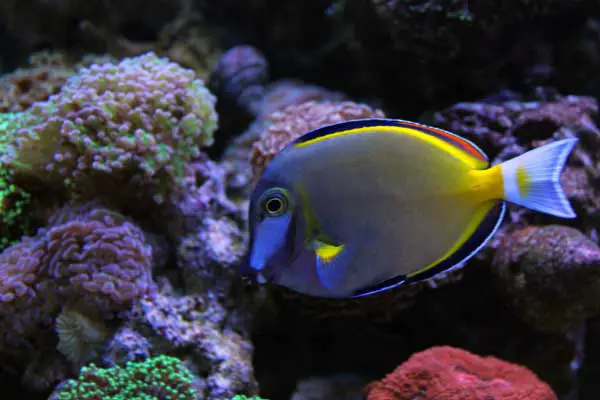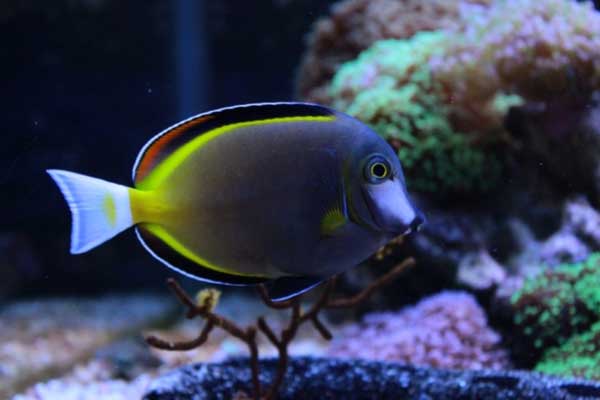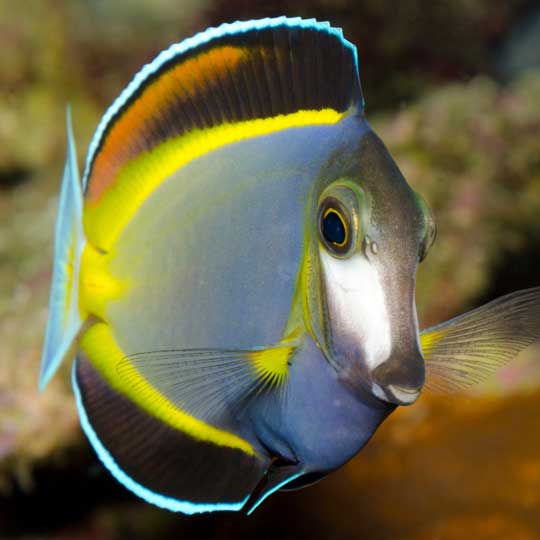Looking for an amazing saltwater fish that is both amazingly beautiful, yet somehow subdued and less flagrantly colored than most? The white-faced powder brown tang fits that description and more. They are elegant and subtle and challenging to care for.
If you just have a moment to scan, check out the answers to some of the most common questions:
- Are powder brown tangs aggressive?
- Are powder brown tangs hard to keep?
- What are some great tankmates to pair with this great fish?
- What do powder brown tangs eat?
- Are brown tang fish omnivores?
Let’s talk a bit more about what makes them challenging after a few quick facts.
Quick Facts About the White-faced powder brown tang:
- Scientific Name: Acanthurus japonicus
- Common Names: Gold-rimmed tang, Powder brown surgeonfish
- Max Size: About 8 inches
- Minimum Tank Size:125-Gallons
- Aggression Level: Semi-Aggressive
- Color: Yellow, Grey, Blue, White, Black, Brown
- Care Level: Expert
- Most Active: Day
The natural habitat of Acanthurus japonicus
The powder brown tang hails from reefs in the Western Pacific, and like their scientific name suggests, they are commonly seen in warm water reefs around parts of Japan, as well as other parts of the Indian and Pacific Oceans, including Taiwan and the Philippines.
Are powder brown tangs hard to keep?
The short answer is yes, powder brown tangs are hard to keep. They are large, active swimmers that require a lot of room to swim (therefore requiring a very large system, which on its own merit skews towards advanced/expert) and are prone to parasites/disease like marine ich, making them relatively hard to keep.
Proper tank conditions & Powder brown tang behavior
The powder brown tang grows to be about 8 inches in length, as a fully grown adult. That means they are larger than most of the smaller saltwater fish (gobies, basslets, damselfishes, clownfishes, blennies, etc.,) but are actually one of the smaller tang species–nearly 10 inches smaller than the gorgeous Naso tang (Michael 2001).
Since all tang types and surgeonfishes (that I know of, at least) are extremely active, open-water swimmers, the minimum recommended tank size is about 125-gallons, and others may even disagree with this and say they require even more space. This, unfortunately, makes Acanthurus japonicus an unlikely addition to our tanks for most of us fish-lovers with tank sizes less than 125 gallons.
These gold-rimmed tangs are ideally suited for a large, open reef tank, that has both:
- Plenty of open space to swim
- Lots of live rock to graze on
They are not particularly picky about water conditions. Standard reef tank water is sufficient. They do require a lot of oxygen and do best in well-aerated tanks with great water movement (Fenner 2001). Tangs have been known to be sensitive to copper.
Stress
These fishes are prone to marine ich and can succumb to the parasite (seemingly out of nowhere…) when stressed. Therefore it is best to quarantine them upon arrival and also ensure you’re monitoring them for stress, once added to your new system–especially if there is a risk they could get ich while in your system.
While in quarantine, you can be sure to feed them well and beef them up for the journey to your display tank.

Handling
Remember that the surgeonfishes get their name because they have a blade-like ‘scalpel’ by their tail that they will use to slash at enemies or when scared. Be careful when reaching into the tank to avoid getting slashed and also use care when transporting your tang. Nets can cause damage to the skin (making them more susceptible to ich) and their scalpel can get stuck in the mesh. Best to transport them with large, rigid specimen containers, instead.
You can buy a specimen container here.
How big do Powder brown tangs get?
Powder brown tangs grow to a maximum adult size of about 8 inches in total length and they require a minimum tank size of 125 gallons.
Compatibility with and aggression in the white-faced powder brown tang
The white-face powder brown tang is an interesting fish to consider, in terms of community fish compatibility. Firstly, they are considered to be reef safe and should not disturb your corals or other invertebrates.
They are also largely tolerant of other non-surgeonfish species and make a good community fish addition. However, aggression creeps into the picture in two different scenarios.
The first scenario is…over time…if you add a powder brown tang to your tank early in the process of stocking your tank and then, therefore start to add other fishes to the tank later, your gold-rimmed tang may become aggressive towards those newcomers, defending its territory by flipping its tail (and the business-end of the scalpel) at them.
This relative aggression is variable based on the individual specimen you have (how aggressive the individual is) and time in your aquarium (without disruption) such that it has identified with its territory.
The other scenario, which is much more consistent, and therefore predictable, is to expect serious aggression with other tang species. The golden rule here is to keep only one tang per tank.
Expert aquarists with very large systems are generally able to house multiple tangs, but I recommend doing some specific research there before attempting that–and only when you know you have sufficient aquarium volume.
Since they are relatively large, themselves (about 8-inches, when fully grown), are fast-swimming and can defend themselves a bit, with their scalpel, you could also keep them with some of the other larger and aggressive fish species.

Are Powder brown tangs aggressive?
The Powder brown tang, like other members of the tang family, is considered to have semi-aggressive behavior. That means they will occasionally be aggressive to other members of a community aquarium, whipping them with the sharp scalpel by their tail, and will be outwardly aggressive to other tang species.
Powder brown tang tankmates
There are a lot of different community saltwater aquarium fish species that would be perfect tankmates for the Powder brown tang, but here are a few suggestions, to get you started:
- The Marine betta
- Flame angelfish or Bicolor angelfish
- Banggai cardinalfish or Pajama cardinalfish
- Clownfish species, like the Ocellaris clownfish or even the Tomato clownfish
- Sand sifting or digging goby species, like the Engineer goby or the Diamond goby
They will also be great tank mates to keep with Mushroom corals, Zoanthids, Large Polyp Stony, or Small Polyp Stony corals
Can you keep a Powder brown tang and Powder blue tang together?
It is not recommended to keep two tangs in the same aquarium, but it is occasionally possible in very large tanks (180 gallons and above), when the fish are introduced to the display tank at the same time. You could potentially keep a Powder brown and a Powder blue together in a large reef tank like this, if introduced together, but this should be left o aquarists with significant experience dealing with aggression between fish.
Breeding, spawning, and rearing in captivity
Breeding tangs in captivity was originally thought to be too difficult but has become a real scenario over the past few years. The landmark aquaculture of the Yellow tang, the powder brown tang’s close cousin, provides hope for the bold, with lots of time, resources, and a monster aquarium.
Breeding these fishes in captivity will not be easy. The first challenge will be to establish a pair, given that it is difficult to detect differences between males and females–and in establishing a pair without all the fighting you would expect.
They are also broadcast spawners, which means they cast their eggs in the open water, rather than lay them on a substrate, which means you need to have a method to collect the eggs and/or larvae. Finally, the larvae are quite small and challenging to raise.
With that said, if you succeed, you will become instantly famous (in aquarium circles) and be my hero for the day :). Need any more motivation?
What do powder brown tangs eat?
Powder brown tangs are not thought to be strictly herbivorous, which makes them an omnivore, technically, but they do heavily graze on algae. In fact, they are one of the 21 best algae-eating saltwater fish. They will eat filamentous blue-green microalgae, as well as filamentous and fleshy red algae. They will naturally graze on your rocks, aquarium glass, and equipment all day long and will also greedily eat flakes and frozen foods as well, once acclimated.
Are powder brown tang fish omnivores?
Yes, powder brown tang fish are omnivores and will eat meaty and plant-based foods and will nip at algae and algal films in a saltwater aquarium.

What type of food?
Prepared foods that include vegetable matter, like nori and other dried seaweeds, as well as spirulina-based foods and meaty foods, like black worms, brine shrimp, and mysis shrimp.
Acanthurus japonicus, or the orange-rimmed surgeonfish can get stressed out by the travel from their home to yours and certain individuals struggle to acclimate to aquarium life.
Head and lateral line disease
Tangs kept in cramped quarters, poor water quality, or with insufficient nutrition, stray electrical voltage, or even those that run activated carbon can disproportionately develop a medical condition called head and lateral line disease or lateral line erosion. The best option for treatment is rapid detection (don’t be in denial), troubleshoot the issue to remove it, and make sure you’re feeding your tang a high-quality algae-filled diet.
Where to buy a golden-rimmed surgeonfish
I would characterize the Powder brown tang as a moderately-available saltwater fish species. It certainly isn’t one of the most abundantly available fishes or as ubiquitous as the yellow tang, but reputable local fish stores that cater to the saltwater end of the hobby generally do acquire this fish on less frequent rotation.
They are also commonly available online.
Use caution when you see online sales for fish that are less than 3 inches long. These smaller fish are generally more fragile and have a harder time dealing with all the stress of transfer.
Look for a fish that is thick throughout with strong muscle on their dorsal spine behind their head. Watch for bold, energetic behavior and think twice about thin, malnourished, pale, or any fish that is itching/scratching on rocks.

Whether to Buy a Powder Brown Tang or Not
This is the part of the article where I typically espouse the pros and cons of the fish in question and let you know whether it would be a good choice for your setup. If you read the article up until this point, it probably won’t surprise you that I’m a bit conflicted here.
If you are looking for a subtly gorgeous, relatively smaller surgeonfish–and you have space and patience to meet their care needs, then a powder brown tang is a good choice.
If your tank is less than 90-gallons…and you’re trying to talk yourself into thinking your 70-gallon tank is big for its size…or that you’ll give the fish away when it gets too big…or if you can only afford one of the 2-inch juveniles. You and the fish are probably better off if you make a different selection. My goal here is to give you helpful information and help you and your underwater friends be successful.
If you read this and are convinced you can meet their needs, perfect! If you aren’t sure, perfect! Thanks for being thoughtful and giving it fair consideration.
Learn more about other Acanthurus tangs
There are several other closely related tang species that are relatively commonly found. Check out these other care guides to find the perfect tang for your tank:
For more information
Are you thinking about adding a tang to your tank but aren’t sure which one to choose? Here are two other extremely popular options:
Or bounce back to the saltwater fish page to check out an entirely new group of fishes, like the coral beauty angelfish or fox face rabbitfish.
Watch this video
To learn more about caring for tangs, including the Powder brown tang, check out this video:
References:
Fenner, Robert M. The Conscientious Marine Aquarist. T.F.H. Publications. Neptune City, NJ 2001.
Michael, Scott W. “Fishy Grazers on the Reef and in the Aquarium.” Coral: the Reef & Marine Aquarium Magazine. Volume 12: Issue 4 Jul/Aug 2015
Michael, Scott W. Marine Fishes: 500+ Essential-to-Know Aquarium Species. T.F.H. Publications. Neptune City, NJ 2001.



Leave a Reply